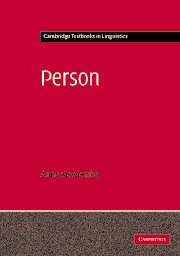Book contents
- Frontmatter
- Contents
- List of figures
- List of tables
- Preface
- List of abbreviations
- 1 Introduction
- 2 The typology of person forms
- 3 The structure of person paradigms
- 4 Person agreement
- 5 The function of person forms
- 6 Person forms and social deixis
- 7 Person forms in a diachronic perspective
- Appendix 1 List of languages in the sample by macro-area
- Appendix 2 Genetic classification of languages cited in the text
- References
- Author index
- Language index
- Subject index
Appendix 1 - List of languages in the sample by macro-area
Published online by Cambridge University Press: 05 June 2012
- Frontmatter
- Contents
- List of figures
- List of tables
- Preface
- List of abbreviations
- 1 Introduction
- 2 The typology of person forms
- 3 The structure of person paradigms
- 4 Person agreement
- 5 The function of person forms
- 6 Person forms and social deixis
- 7 Person forms in a diachronic perspective
- Appendix 1 List of languages in the sample by macro-area
- Appendix 2 Genetic classification of languages cited in the text
- References
- Author index
- Language index
- Subject index
Summary
Eurasia 55
Abkhaz, Ainu, Akkadian, Albanian, Armenian (Eastern), Basque, Brahui, Burushaski, Chepang, Chinese (Mandarin), Chukchi, Crimean Tatar, Dagur, Dong, Dutch, English, Evenki, Finnish, French, Garo, Georgian, German, Greek (Modern), Hindi, Hittite, Hungarian, Hunzib, Ingush, Irish, Italian, Japanese, Ju-chen, Kannada, Kashmiri, Ket, Khalkha, Korean, Kurdish (Central), Lak, Latvian, Lezgian, Mundari, Nenets, Nivkh, Ossetic, Persian, Polish, Remo, Russian, Spanish, Sumerian, Turkish, Udihe, Welsh, Yukaghir (Kolyma)
Africa 81
Amharic, Ani, Arabic (Egyptian), Babungo, Bagirmi, Bambara, Bari, Beja, Berta, Bilin, Bimoba, Boni(Jara), Burunge, Coptic, Dagaare, Diola-Fogny, Dizi, Dogon, Dongolese Nubian, Doyayo, Ewe, Fula, Fur, Geez, Grebo, Gude, Hamar, Hausa, Hebrew, Igbo, Iraqw, Kana, Kanuri, Katla, Kera, Kisi, Koh (Lakka), Kolokuma (Ijo), Koma, Kongo, Koromfe, Koyra Chiini, Kreol (Mauritian), Krongo, Kuku, Kunama, Lango, Lele, Luvale, Maale, Maba, Mbay, Mende, Mesalit, Mumuye, Mupun, Murle, Nama, Nandi, Ndonga, Ngiti, Nkore Kiga, Noon, Nupe, Oromo (Harar), Pari, Sandawe, Sango, So, Songhay (Koyraboro), Supyire, Swahili, Tamazight (Ayt Ndhir), Turkana, Wolaytta,!Xu, Yaoure, Yoruba, Zande, Zulu
South-East Asia and Oceania 62
Acehnese, Adzera, Anejom, Atayal, Bawm, Burmese, Byansi, Chamorro, Chrau, Dehu, Fijian, Hmong Njua, Indonesian, Kaliai Kove, Kapampangan, Karo Batak, Kayah Li, Khasi, Khmer, Khmu, Kilivila, Kiribatese, Konjo, Kusaiean, Ladakhi, Lahu, Larike, Lepcha, Limbu, Lolo (Nesu), Lushai, Malagasy, Maori, Meithei, Mlabri (Minor), Mono Alu, Muna, Nakanai, Paamese, Paiwan, Palauan, Rapanui, Rawang, Samoan, Savu, Sema, Semelai, Sundanese, Taba, Tagalog, Temiar, Thai, Tidore, Tinrin, Tolai, Tsou, Tukang-Besi, Uma, Ura, Vietnamese, Woleaian, Yapese
- Type
- Chapter
- Information
- Person , pp. 282 - 283Publisher: Cambridge University PressPrint publication year: 2004

